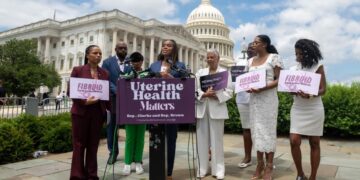March 28, 2025 Story by: Editor
A newly updated analysis by the Environmental Working Group (EWG), co-authored with BLK + GRN Founder Kristian Edwards, DrPH, reveals that only 21% of the 4,011 personal care products marketed to Black women are classified as low hazard in EWG’s Skin Deep® cosmetics database.
The findings highlight ongoing safety disparities in personal care products nearly a decade after EWG’s initial 2016 report on products marketed to Black women. Many popular items—including hair care products, some moisturizers, and certain types of makeup—continue to contain potentially harmful ingredients.
This updated study emphasizes that Black women may have fewer options for low-hazard products. While policy changes and product reformulations since 2016 have led to some improvements, significant disparities remain between products marketed to Black women and those without demographic targeting.
Hazard Ratings and Key Findings
The Skin Deep® database evaluates product safety by analyzing ingredients against over 60 toxicity and regulatory databases, assigning a hazard score from 1 (lowest risk) to 10 (highest risk). The study examined 4,011 products marketed to Black women, revealing that approximately one in 20 ranked as highly hazardous.
The analysis also found:
- Fewer products marketed to Black women were classified as low hazard compared to those without demographic marketing.
- Of the nine concerning ingredients identified in EWG’s 2016 report, eight have become less prevalent in the 2025 report—most notably parabens. However, the use of undisclosed fragrance ingredients has increased.
- Among the 12 product categories analyzed in both the 2016 and 2025 reports, only four showed improvement in safety scores, while eight categories shifted toward moderate or high hazard levels.
- Hair relaxers remain among the most hazardous products. Over 25% of evaluated relaxers contained at least one formaldehyde-releasing preservative, and 78% included the caustic ingredients sodium hydroxide, calcium hydroxide, or both.
Health Disparities and Beauty Justice
Health disparities in the U.S. are well-documented, and environmental justice research has increasingly recognized differences in chemical exposure as a contributing factor. A pivotal 2017 study by university researchers described these disparities as “the environmental injustice of beauty.” Subsequent research has examined how racialized beauty standards play a role in these exposure gaps.
The latest EWG findings align with existing beauty justice research, underscoring the ongoing disparities that disproportionately impact Black women. Studies have linked personal care product exposure to increased health risks, particularly for women of color. For example:
- Exposure studies show that pregnant Black and Hispanic women have higher urinary phthalate concentrations, while Black and Mexican women have elevated levels of phthalates and parabens.
- Health outcome studies suggest that the use of hair dyes and straighteners is associated with a higher risk of breast cancer—an effect more pronounced in Black women than in white women.
- Data from the Black Women’s Health Study found an increased risk of uterine cancer in postmenopausal women who frequently used hair relaxers, though it was unclear whether these were professional or at-home products.
A Harvard study using Skin Deep® scores further revealed that stores in Boston neighborhoods with a higher percentage of residents of color were more likely to sell high-hazard products than those in predominantly white areas. Researchers suggested that such geographic disparities in product safety availability reflect broader systemic inequalities, akin to redlining and discriminatory zoning practices.
Ongoing Disparities in Product Safety
Certain product categories may contribute more significantly to exposure and health disparities due to differences in marketing, usage patterns, and safety profiles. In Skin Deep®, some of the highest hazard categories—regardless of demographic marketing—include hair care and styling products, skin lightening creams, and fragranced lotions and creams. These categories have also been linked to potential health risks for Black women.
The updated EWG analysis aims to assess whether Skin Deep® data can be used to examine these disparities and identify opportunities for safer product development.
Breakdown of Analyzed Products
Between December 2023 and August 2024, EWG conducted in-store and online research, collaborating with BLK + GRN to identify 4,011 products marketed to Black women. While the product distribution by category remains largely similar to the 2016 report, the 2025 study includes more hair care products but fewer makeup products and cleansers.
Changes in Product Safety Scores (2016 vs. 2025)
- Fewer than 25% of products received a low hazard score (1–2) in 2025, consistent with 2016 findings.
- The percentage of products rated as moderate hazard (3–6) increased from 70% in 2016 to 74% in 2025.
- High hazard products (7–10) declined from 8% in 2016 to 4.9% in 2025.
These shifts suggest some formulation improvements in products marketed to Black women. However, disparities persist when comparing these products to those without demographic marketing.
Product Hazard Scores by Category
While some product categories showed safety improvements, others saw an increase in moderate and high hazard scores:
- Improved categories: Hair styling aids (curling wax, mousse, hairspray), facial powder, bar soap, and facial moisturizers saw a slight shift toward safer formulations.
- Worsened categories: Body moisturizers, body oils, body wash, and eye shadow exhibited higher hazard scores. Notably, no low-hazard eye shadow products remained in 2025, though the small sample size makes this trend less definitive.
Differences Between Demographic and Non-Demographic Marketing
Overall, products marketed to Black women were less likely to score as low hazard compared to products without demographic targeting:
- 21.1% of products marketed to Black women were classified as low hazard, compared to 27.4% of non-demographic products—a gap of six percentage points.
- This suggests that Black women who purchase products specifically marketed to them are more likely to use moderate hazard products than those buying general-market items.
Hazard Variations Across Product Types
Among makeup products, lip gloss, blush, and eye shadow marketed to Black women generally scored worse than comparable products without demographic targeting. While the overall score range for lip gloss remained consistent, the mean and median hazard scores for lip gloss marketed to Black women were higher.
Hazards in Beauty Products Marketed to Black Women: Trends and Safety Concerns
The findings of this analysis highlight disparities in the safety of personal care products marketed to Black women, particularly in categories such as makeup, hair care, and skin care. While some improvements have been made in reducing hazardous ingredients, many products still contain chemicals linked to health risks.
Persistent Concerns in Makeup and Hair Care
Blush, eye shadow, and hair products marketed to Black women continue to show higher hazard scores compared to those without demographic marketing. Although the median score for blush remained moderate (4), the overall trend suggests fewer low-hazard options for consumers. Similarly, hair color, bleaching products, and hair loss treatments scored higher in hazard assessments when targeted at Black women, raising concerns about prolonged exposure to harmful substances.
The study also found that hair relaxers, a historically controversial product category, have shown a decline in their average hazard score from 8 in 2016 to 5 in 2025. However, this decrease does not eliminate concerns, as most relaxers still contain caustic hydroxide ingredients such as sodium hydroxide and calcium hydroxide. Additionally, 25.9% of hair relaxers continue to include formaldehyde-releasing preservatives, posing health risks such as skin irritation and respiratory issues.
Ingredient Trends and Emerging Concerns
An encouraging trend is the decline in the prevalence of eight of the nine ingredients of concern identified in the 2016 report. Notably, the use of parabens—such as propylparaben and butylparaben—has significantly decreased. However, the presence of undisclosed fragrances has increased by 6.4 percentage points, raising concerns about transparency and potential hidden risks.
Among the most commonly found hazardous ingredients in personal care products marketed to Black women in 2025 are:
- Cetrimonium chloride and behentrimonium chloride (found in conditioners) – linked to respiratory issues and reproductive health risks.
- Lilial (lily aldehyde) – a fragrance ingredient banned in the EU due to its reproductive toxicity.
- DMDM hydantoin – a preservative that releases formaldehyde, a known carcinogen.
- Triethanolamine – an ingredient that can form carcinogenic nitrosamines and has been associated with asthma.
Regulatory Developments and Beauty Justice
Efforts to improve safety and reduce exposure disparities have gained momentum. The 2022 Modernization of Cosmetics Regulation Act has granted the FDA greater authority to regulate personal care products, marking the most significant legislative update since 1938. Additionally, the CROWN Act, which bans race-based hair discrimination, has been adopted in multiple states, reflecting progress in challenging racist beauty standards.
Despite these advances, achieving true beauty justice requires systemic change. Products marketed to Black women must be made safer, with greater transparency about ingredients and potential hazards.
Recommendations for Safer Choices
Consumers can take steps to reduce exposure to harmful chemicals by:
- Using EWG’s Skin Deep database to check product safety ratings before purchasing.
- Choosing products with lower hazard scores, especially when it comes to long-term exposure.
- Supporting policies that demand stricter regulations and greater ingredient transparency in personal care products.
By continuing research, advocating for better safety standards, and increasing awareness, the beauty industry can work toward creating safer and more equitable product choices for Black women.
Source: EWG
















